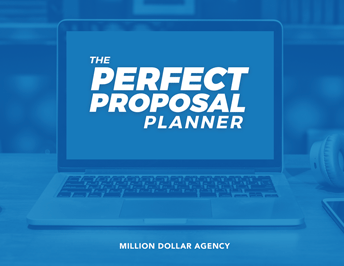How to Qualify Prospects Fast without Wasting Time with Tire Kickers

Your time is valuable. So set your calls up for success by qualifying your prospects early on.
How many calls does your agency make in a day?
Making calls may be par for the course when it comes to your line of business. But if you’re wasting 30 to 45 minutes per call on people who aren’t going to convert, chances are you’re working too hard.
Yet many agencies do it.
Making 6 or 7 calls a day doesn’t seem problematic if you manage to convert those prospects. However, you may need to look at this realistically. And the realistic number is only 20% conversion.
Such a low number isn’t going to get you anywhere.
But do you know what would get you somewhere? Making structured calls.
When you make structured calls, you can find out if a lead qualifies quickly. That way you know almost immediately whether the person has a good chance of converting.
Creating a structure for your calls could save you time and money.
So stop throwing your valuable time away and qualify your prospects quickly. And check out these tips to streamline your call process.
The 15-Minute Fit Finder
Is this scenario familiar?
Your agency makes call closes all the time. So you spend upwards of 45 minutes on a call, but you don’t even know if the prospect qualifies.
At the end of the call, the prospect may have one of two responses:
- Can you send me more information?
- You’re out of my budget.
Both responses are the last thing you want to hear. You’ve just spent a large percentage of your productive hours on an unqualified prospect. And it happens a lot for agencies.
So what do you do? You streamline and structure your calls.
Find out if your prospects qualify early in the call. Using the 15-Minute Fit Finder structure, you can find out quickly if you should continue the call. Or mark the prospect off as unqualified.
This is how the process works. Break prospect calls into 2 categories:
- 15-minute qualification
- 45-minutes strategy session, if qualified
These don’t happen at the same time. Instead, think about having a “qualification day” or a “strategy session day.” On these particular days, your agency focuses on just those aspects.
You also don’t have to do both on the same day.
Suppose you have 25-minute slots for calls for your agency. You may slot those 25 minutes to look like this?
- 15-minutes for conversation
- 10-minutes for prepping the next call/taking a break
The actual structure of the conversation needs to be very regimented. But it may also vary depending on what suits your agency’s needs the best.
The Tips
Your call structure may be very different from another agency’s Fit Finder. But here are some tips to help you get started on designing your own call structure.
Tip #1 – Get Them to Call You
First, get the prospect to call you.
This may be different than what you’re used to because you normally make the calls out.
This is the first step in call control. Why? Because now you’re the one picking up the phone to answer the call.
When you pick up that call, you can say something like:
- I’ve been expecting your call
- It’s on the calendar
- We’ve got a solid 15 minutes to talk
- I’ve got a call immediately after this
All these phrases position you into a place of control in the call.
The prospects take the first step to contact you. And when you let them know that you’re busy but can chat with them implies that:
- you have a lot of business
- you’re successful at what you do
- you think they’re valuable enough to fit them into your busy schedule
Also, let them know that you were expecting their call. That gives them some sense of responsibility for making that call to you. And that contacting you was their choice.
This can be empowering when creating a relationship with a prospect. They don’t feel as if you’re thrusting yourself into their time and life. Instead, they make the choice to pick up the phone and call you.
Tip #2 – Establish the Framework of the Call
Next, you want to establish a framework for the call. This tip is important because, without the framework, you may run into the same problem that you have right now – wasted time.
Establishing a framework keeps you both on task.
In addition, you can also simply let them know that your agency has a bit of a framework for these types of calls. Lay the process out for them, saying things like:
- I’m going to ask you a few questions about your situation
- I’m going to let you know if and how we can help you
- You’re also going to have a chance to ask us questions as well
- I’ll let you know if we’re a good fit
- If you’re not a good fit, I can point you in the right direction
Outlining your framework on paper and out loud to your prospect keeps the call on point. And it lets them know that you:
- have experience and a framework that works
- think their time is valuable
Tip #3 – Ask “Why Us?”
One of the first questions you may ask is “why us”. You don’t have to say it exactly like that. Start off by asking “why is this a now conversation for you?”
After they give you the answer, follow up with the “why us?”
The answer to this can give you a good indicator of whether you will be able to close them.
Do you want to improve on the 20% close rate? If you do, then they have to have known about you. And you’ll find out if they do when they answer the “why us” question.
If they don’t have a compelling answer, the prospect may be lower in terms of closing.
So, what you want to hear are things like:
- I’ve seen a couple of your videos
- I heard about you from different acquaintances
Tip #4 – Establish Your Mission
Also, remember to establish your mission. After you ask the “why us” question, follow up with your agency mission.
This may obviously vary depending on your agency. But let them know your mission statement and who you’re striving to help.
Tip #5 – Ask About Their Business
Next, it’s time to ask them about their business.
Have you noticed the ebb and flow of the conversation?
Having a call framework doesn’t mean it has to be one-sided.
Ask questions like:
- What do you do?
- What problems do you solve?
- How does your solution work?
Tip #6 – Ask About the Current Situation
After they tell you their story, you’re going to frame it back to them to make sure you understand it. However, there is a slight difference when you frame their story back.
As you repeat their story, frame back the fact that they don’t have a solution yet.
Tip #7 – Ask What They Think Is Missing
The follow-up to the discovery of their current situation is to ask them what’s missing. You can frame it in different ways:
- What do you think is missing?
- What is holding you back from your goals?
They may tell you a bulleted list of things they want to change.
Pay attention and write them down because you may need to refer back to them later.
Tip #8 – Ask What They Think They Need from You
In addition, find out what they need from you. This is a great follow-up to that bulleted list they just gave you.
They may actually give you a definite answer like:
- I need a plan
- I need a diagnostic
Or they may simply say that they just want you to make their phones ring.
You may also ask if it’s a priority thing right now, or if they think it will be one later on. Try to be casual when you ask it.
Sooner or later you will have to clarify this point. So this is a good point to ask.
Tip #9 – Reiterate and Close with What You Think the Next Step Should Be
Finally, reiterate the conversation back to them.
Frame back the problem that they’re having and what their goals are and close the call.
Remind them of what your agency does and that you think you could help them. Don’t start a strategy meeting right then and there, though.
Instead, let your prospect know that they should sit down for a 45-minute strategy session. So the next step should be waiting to hear from your assistant to book an appointment and to start planning.
End the call by letting them know you have to pick up another call soon. But they can expect to hear from your assistant regarding the next step.
The Final Word
Can you compress all 9 points into a 15-minute call?
Yes!
This call framework leaves very little room to go off on tangents. The questions are geared in such a way that you have control of the call from the beginning and set the tone.
So maybe it’s time to create a 15-minute Fit Finder that’s tailored to your agency’s needs. Structure your calls to make them work for you and stop wasting your valuable time on unqualified prospects.
Dev “Prospect Qualifier Boss” Basu




